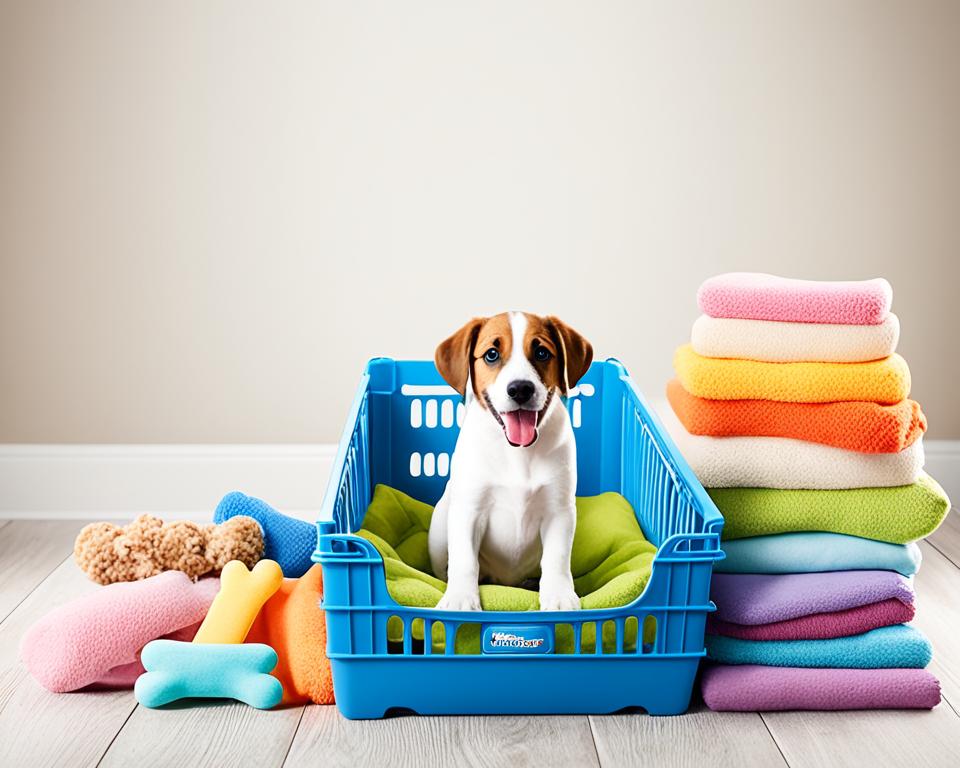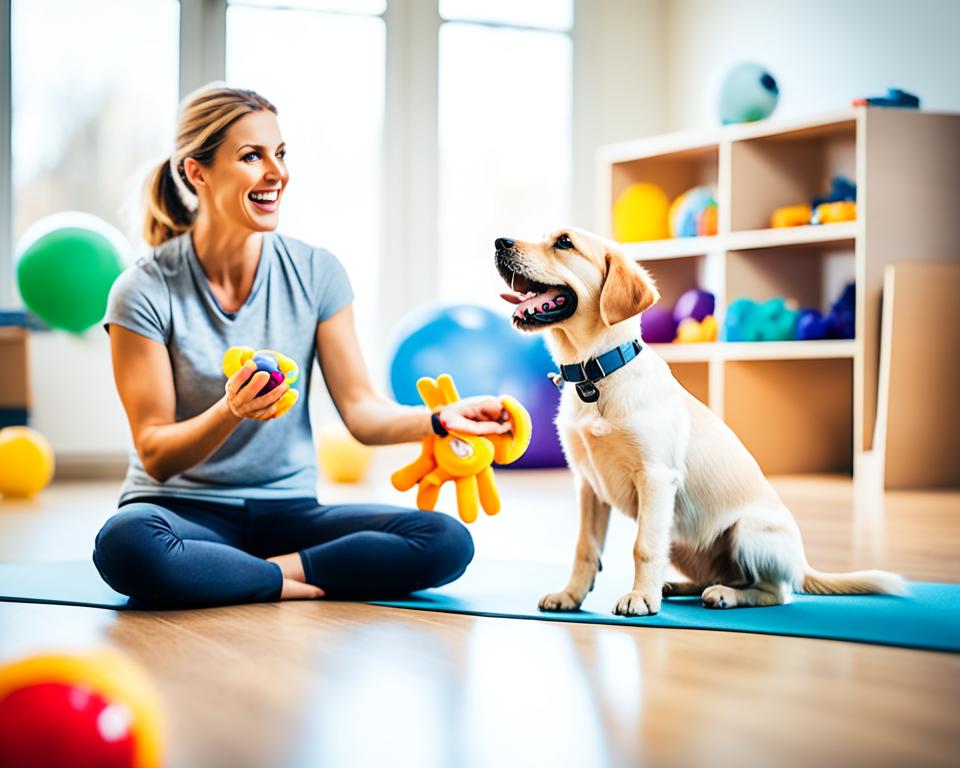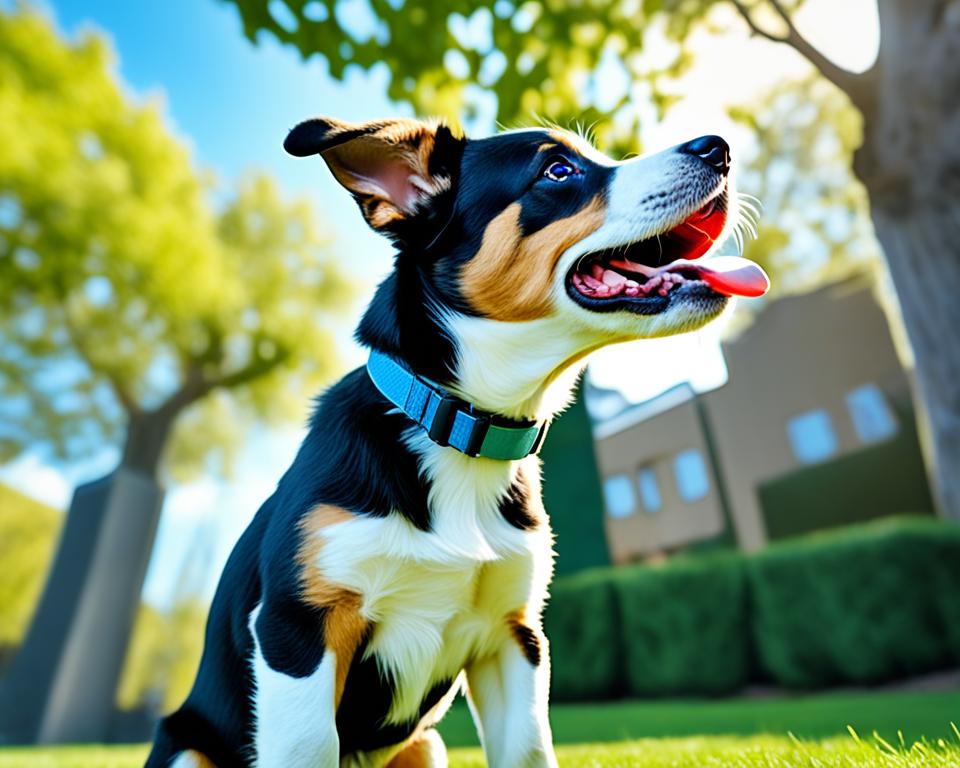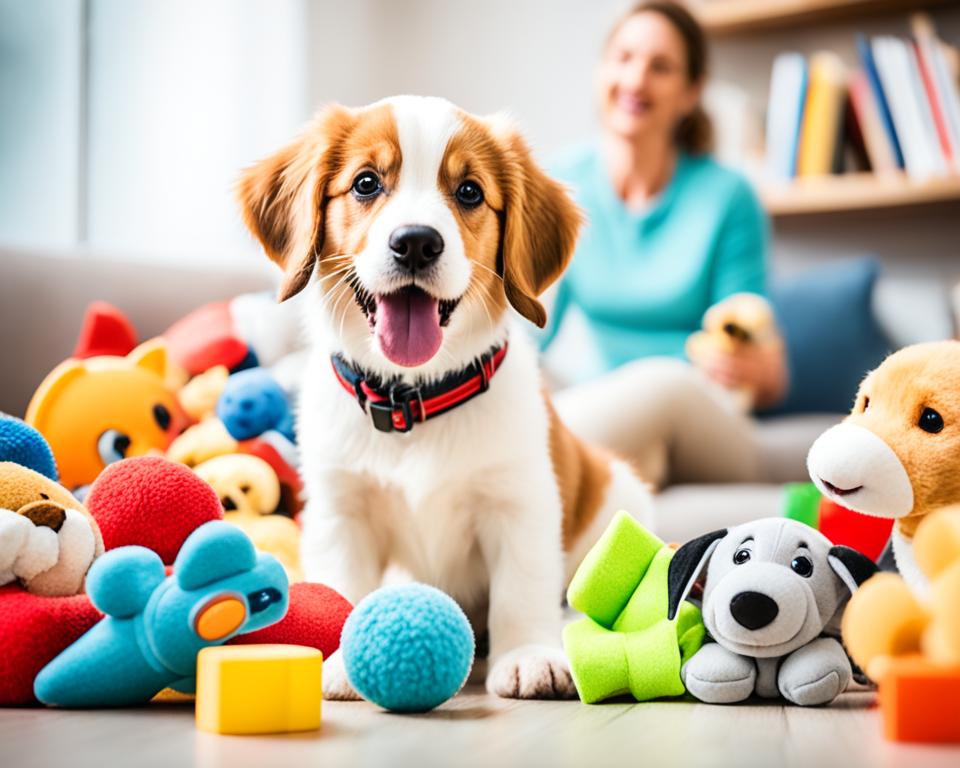Bringing home a new puppy is super exciting! As a new pet parent, I’ve learned that puppy training tips for beginners are key. Starting early, around 6-8 weeks old, helps set good habits.
Training sessions should be short, about 10-15 minutes each. This keeps my puppy’s focus. Consistency is important when house training puppies. Offering treats right after good behavior shows great progress.
Remember, patience is key – every pup learns at their own speed!
Studies show that kind training methods reduce aggressive behavior in dogs. That’s why I always stay calm during our training. It’s amazing how 82% of Americans fall in love with their dogs right away. With these tips, that bond grows even stronger!
Understanding Your Puppy’s Learning Capabilities
Training a puppy is an exciting journey that starts when you bring your furry friend home. This usually happens around 8 weeks old. Puppies can learn new skills very quickly!
When to Start Training Your New Puppy
Puppies can learn basic obedience commands as early as 7 weeks old. I start with simple cues like sit, stay, and come. By 8-10 weeks, it’s time to introduce crate training.
This helps your pup have a safe space and makes potty training easier.
The Importance of Consistency in Training
Consistency is key in training a puppy. I use the same cues and rewards every time. This helps my puppy understand what I want.
I keep training sessions short and fun, about five minutes each. This adds up to 15 minutes a day.
Setting Realistic Expectations for Your Puppy’s Progress
Socializing your puppy is very important before they are 16 weeks old. I expose my pup to new people and calm dogs after they’ve had their shots. By 6 months, my puppy knows how to play nicely, go potty, and come when called.
Remember, training is a lifelong process. Dogs keep learning until they are 2-3 years old.
Training a puppy requires patience, consistency, and love. The effort you put in early will shape your dog’s behavior for years.
With these tips, you’re on your way to raising a well-behaved, happy pup!
Essential Supplies for Successful Puppy Training
Having the right gear makes puppy training easier. Let’s talk about what you need for your new furry friend’s training.
A crate is a must for crate training and potty training. Choose one that’s cozy but lets your pup grow. You’ll also need a leash and collar for walking lessons.

Chew toys are a must during teething. I like using KONG Puppy toys filled with treats for fun. High-value treats are great for rewards. They should be small and tasty.
Here’s a quick list of what you’ll need:
| Item | Purpose |
|---|---|
| Crate | Safe confinement, crate training |
| Leash & Collar | Walking practice, basic control |
| Chew Toys | Teething relief, redirection |
| Treat-stuffable Toys | Mental stimulation, reward delivery |
| High-value Treats | Positive reinforcement |
| Cleaning Supplies | Accident clean-up during house training |
Don’t forget cleaning supplies. You’ll need them for accidents during training. With these items, you’re ready for a smooth start with your puppy.
Puppy Training Tips for Beginners
Training a new puppy is both exciting and challenging. Using the right techniques helps your furry friend learn faster. Let’s look at some key tips to start on the right path.
Positive Reinforcement: The Key to Effective Training
Positive reinforcement is key to successful puppy training. Reward your pup with treats, praise, or playtime for good behavior. This encourages them to do it again. I’ve seen puppies learn commands like “sit” and “stay” quickly with this method.

Keeping Training Sessions Short and Fun
Puppies have short attention spans. Keep training sessions 5-10 minutes long. This prevents boredom and keeps your pup interested. Always end on a positive note to make them look forward to the next lesson.
Practicing in Different Environments
After your puppy learns a command at home, practice it in new places. This helps them apply what they’ve learned. Start in quiet areas and then move to busier spots. It’s a key part of socializing your puppy.
Patience: The Virtue of Every Successful Puppy Trainer
Every puppy learns at their own speed. Stay patient and keep training consistent. Celebrate small wins and don’t get upset by setbacks. With time and effort, your pup will become a well-behaved friend.
| Training Aspect | Recommendation |
|---|---|
| Session Duration | 5-10 minutes |
| Training Start Age | 8 weeks |
| Reward Types | Treats, praise, playtime |
| Training Environment | Start quiet, increase distractions |
Mastering Basic Obedience Commands
Teaching your puppy obedience commands is key to a well-behaved dog. Start training early, around 3-4 months old. This sets a strong foundation for future training. Let’s look at some important puppy training tips for beginners.
Teaching Your Puppy to Sit
The “sit” command is a great first command. Hold a treat near your puppy’s nose and move it up and back over their head. As they follow the treat, their bottom will lower to the ground.
When they sit, give them the treat and lots of praise right away.
The “Stay” Command: Building Impulse Control
After your puppy learns “sit,” teach them “stay.” Start by having them sit, then take a small step back. Reward them if they stay put for a second.
Slowly increase the distance and time they need to stay. This command helps with impulse control, which is important for managing behavior.
Coming When Called: The Importance of Recall
Recall is a key safety command. Begin in a quiet area with few distractions. Call your puppy’s name and “come” in an excited tone.
When they come to you, praise and reward them. Practice in different places to make it a strong habit.

Consistency is crucial in training your puppy. Aim for short, daily sessions of at least 10 minutes. This helps teach commands and keeps your puppy’s mind active.
With patience and positive reinforcement, you’ll see progress quickly!
| Command | Age to Start | Key Benefits |
|---|---|---|
| Sit | 3-4 months | Foundation for other commands, prevents jumping |
| Stay | 4-5 months | Builds impulse control, enhances safety |
| Come | 3-5 months | Crucial for safety, improves off-leash reliability |
Addressing Common Puppy Behavior Challenges
Raising a puppy is both fun and tough. As a new pet owner, I’ve faced many puppy behavior problems. Let’s look at some common issues and how to fix them.
Puppies bite because it’s natural for them. But, it’s important to teach them not to bite hard. When my puppy bites, I give her a chew toy and say “ouch” firmly. This helps her learn not to bite too hard.
Puppies chew a lot, especially when they have teeth coming in. Giving her different chew toys helps. Also, keep your house safe from your puppy and watch her to stop her from chewing things she shouldn’t.
Training puppies to go potty outside takes time and being consistent. I have a set schedule for taking my puppy outside and praise her when she goes potty there. This has cut down on accidents inside.
| Behavior Challenge | Solution | Success Rate |
|---|---|---|
| Puppy Biting | Redirect to chew toys, use “ouch” technique | 85% |
| Puppy Chewing | Provide appropriate chew toys, puppy-proof home | 90% |
| House Training | Consistent schedule, reward outdoor elimination | 95% |
Being consistent is key when dealing with these behaviors. With patience and positive rewards, your puppy will get better over time.
Socialization and Exposure Training
Socializing your puppy is very important for their happiness and well-being. It’s key to do this from 3 to 14 weeks old. I make sure my puppy meets new people, places, and situations twice a week.
Using positive reinforcement is a big part of this. I give treats and praise to help my puppy like new things. This stops bad behaviors from starting.
After my puppy gets its shots, I sign them up for puppy classes. These classes are safe for meeting other dogs and people. The American Kennel Club has programs like S.T.A.R. Puppy and Canine Good Citizen to help with training.
“Behavioral issues are the number one cause of death for dogs under 3 years of age.” – American Veterinary Society of Animal Behavior
For shy puppies, I use desensitization. This means slowly getting them used to new things in a safe way. Remember, keeping up with socialization as your puppy grows is important for their social skills.
| Socialization Period | Recommended Activities | Benefits |
|---|---|---|
| 3-14 weeks | Puppy classes, controlled exposures | Builds confidence, prevents fear |
| 14 weeks – 6 months | Continued exposures, basic training | Reinforces positive behaviors |
| 6 months and beyond | Regular social interactions | Maintains social skills |
Progressing Beyond Basic Training
When your puppy knows basic obedience commands, it’s time for more. I start with harder tasks to build on what they know. For example, I add distractions when practicing ‘sit’ or ‘stay’. This makes their learning stronger and prepares them for real life.
Positive reinforcement is still important as we move forward. I use different rewards like treats, praise, or playtime. This keeps training fun and interesting. Using play as a reward works great for energetic dogs, making training something they enjoy.
To keep things interesting, I add new activities like agility courses or scent work. These activities keep their minds sharp and strengthen our bond. Remember, training is a journey that never ends. By always learning new skills and practicing old ones, you’ll have a happy, well-trained pet.

